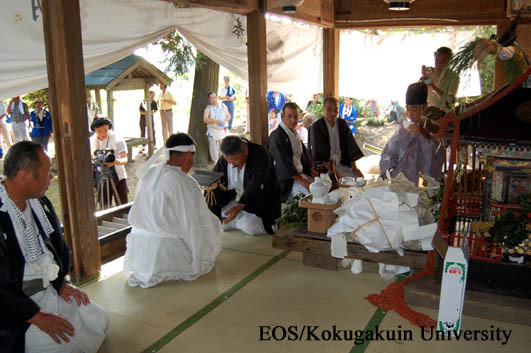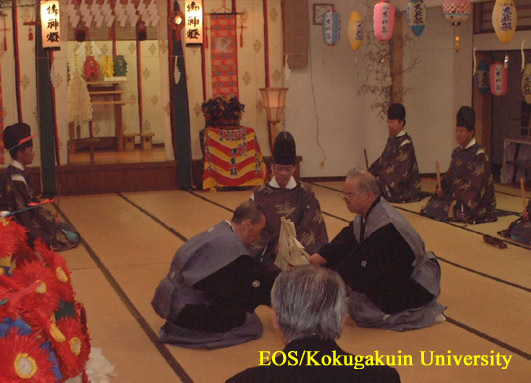Encyclopedia of Shinto
| Main Menu: | |
| Links: |
詳細表示 (Complete Article)
| カテゴリー1: | 6. Belief and Practice |
|---|---|
| カテゴリー2: | Associations and Organizations |
| Title | Tōya |
| Text | At times of shrine festivals or kō events, this term refers to the people who take care of those rituals and events, or it refers to their families. Sometimes just "tō" is used as designation, and in many cases it is written 当屋 (not 頭屋). Tō refers to the supervisor or caretaker of a certain affair. This office was created in the great Buddhist Temples in the Heian period. For example, there were the Tōdaiji hachiman's tegaie no uma no tō or the Hiyoshi Shrine's (present day Hiyoshi Grand Shrine, Hiyoshi taisha) goku tō. Eventually, in order to equalize the burden of purification (kinki) and religious abstinence (kessai), along with the financial burden that went along with kami rituals and holidays, a system of alternation was begun and from there the idea of a tō functionary was born. Thereafter, the individual that this fell to came to be called the tōnin or the shinji tōnin. Thus, the idea was born to call that family the tōya. Its first appearance in literature was in the Ōmi ōshima okitsushimake monjo dating to 1372, in which the term tōke is used. The tōya has a particularly important existence with the miyaza. The miyaza is also called the tōya nakama (colleagues or partners) which highlights its feature of a continually alternating tōya. Even in the old form of miyaza that had ujiko conducting kami rituals without a professional priest, the tōya was not a substitute for a kannushi itself. However, in some regions, they were referred to as kannushi tōya. Eventually, professional priests were created and along with that came the tendency for the contents of kami rituals to become more complex. Thus, it became difficult to carry out kami rituals by means of the ujiko's abilities alone, and so it happened that the tōya became the priest's assistant. There are various ways of selecting tōya. One way is by drawing lots; one is by order of age; another by order of becoming an ujiko; one is by rotation from door to door; and there is also the way of following a fixed household order determined by precedent. Tōya usually alternate every year, and at the times of alternation a ceremony called the "tōwatashi" is conducted and the presentation and take over of the ritual implements and the rosters is performed. Sometimes, there are cases when a small altar for the honored spirit is taken over and enshrined in the tōya house. When one is selected to be a tōya, strict abstinence must be carried out and all impurities avoided. It is standard to aim for absolute purification of the body. — Iwai Hiroshi |






